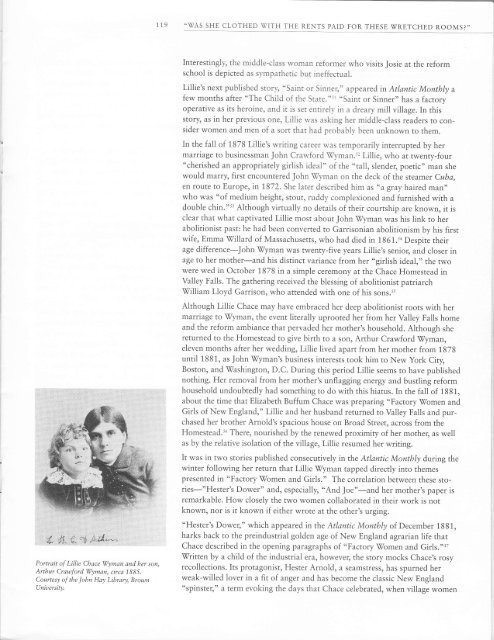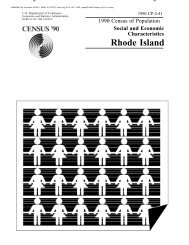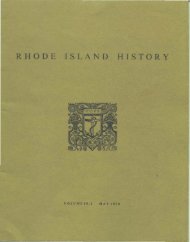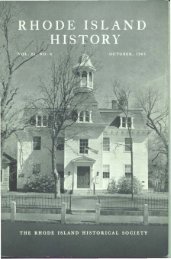Untitled - Rhode Island Historical Society
Untitled - Rhode Island Historical Society
Untitled - Rhode Island Historical Society
Create successful ePaper yourself
Turn your PDF publications into a flip-book with our unique Google optimized e-Paper software.
Portrait of Lillie Chace rX/yman and her son,<br />
Arthur Crauford Wyman, circa 1BB5.<br />
Courtesy of the John Hay Library, Brown<br />
Uniuersity,<br />
I19 "I(/AS SHE CLOTHED WITH THE RENTS PAID FOR THESE WRETCHED ROOMS?"<br />
Interestingln the middle-class rvoman reformer who visits Josie at the reform<br />
school is depicted as sympatheric but ineffectual.<br />
Lillie's next published srorl', "sainr or sinner," appeared in Atlantic Monthly a<br />
fewmonths after "The child of rhe state."'" "Saint or sinner" has a factory<br />
operative as its heroine, and it is set entirelv in a dreary mill village. In this<br />
story, as in her previous one, Liilie rvas asking her middle-class readers to consider<br />
women and men of a sort that had probably been unknown to them.<br />
In the fall of 1878 Lillie's writing career was temporariiy interrupted by her<br />
marriage to businessman John Crawford Wvman.52 Lillie, who at twenty-four<br />
"cherished an appropriately girlish ideal" of the "ral1, slender, poetic" man she<br />
would marry, first encountered John wvman on the deck of the steamer cuba,<br />
en route to Europe, in 1872. She later described him as " a gray haired man,,<br />
who was "of medium height, stout, ruddy complexioned and furnished with a<br />
double chin."53 Although virtually no details of their courtship are known, it is<br />
clear that what captivated Lillie most about John \7yman was his link to her<br />
abolitionist past: he had been converted to Garrisonian abolitionism by his first<br />
wife, Emma'sfillard of Massachusetts, who had died in 1861.5a Despite their<br />
age difference-John wyman was twenty-five years Lillie's senior, and closer in<br />
age to her mother-and his distinct variance from her "girlish ideal,', the two<br />
were wed in october 1878 in a simple ceremony at the chace Homestead in<br />
valley Falls. The gathering received the blessing of abolitionisr patriarch<br />
\X/illiam Lloyd Garrison, who attended with one of his sons.r,<br />
Although Lillie chace may have embraced her deep abolitionist roots with her<br />
marriage to Nfyman, the evenr iiterally uprooted her from her Valley Falls home<br />
and the reform ambiance that pervaded her mother's household. Although she<br />
returned to the Homestead to give birth to a son, Arthur Crawford'Wyman,<br />
eleven months after her wedding, Lillie lived apart from her mother from 1878<br />
until 1881, as John \fyman's business interests took him to New York City,<br />
Boston, and \Tashington, D.c. During this period Lillie seems ro have published<br />
nothing. Her removal from her mother's unflagging energy and bustling reform<br />
household undoubtedly had something to do with this hiatus.In the fall of 1881,<br />
about the time that Elizabeth Buffum Chace was preparing "Facrory \7omen and<br />
Girls of New England," Lillie and her husband returned to Valley Falls and pur-<br />
chased her brother Arnold's spacious house on Broad Street, across from the<br />
Homestead.'6 There, nourished by the renewed proximity of her mother, as well<br />
as by the relative isolation of the village, Lillie resumed her writing.<br />
It was in two stories published consecutively in the Atlantic Montbly during the<br />
winter following her return that Lillie'Wyman tapped directly into themes<br />
presented in "Factory'Women and Girls." The correlation between these stoliss-"f<br />
[ss1sr's Dower" and, especially, "And Joe"-and her mother's paper is<br />
remarkable. How closely the two women collaborated in their work is not<br />
known, nor is it known if either wrote at the other's urging.<br />
"Hester's Dower, " which appeared in the Atlantic Monthly of December 1 8 81,<br />
harks back to the preindustrial golden age of New Engiand agrarian life that<br />
Chace described in the opening paragraphs of "Facrory'Women and Girls."r'<br />
's7ritten by a child of the industrial era, however, the story mocks chace's rosy<br />
recollections. Its protagonist, Hester Arnold, a seamstress, has spurned her<br />
weak-willed lover in a fit of anger and has become the classic New England<br />
"spinster," a term evoking the days that Chace celebrated, when village women











